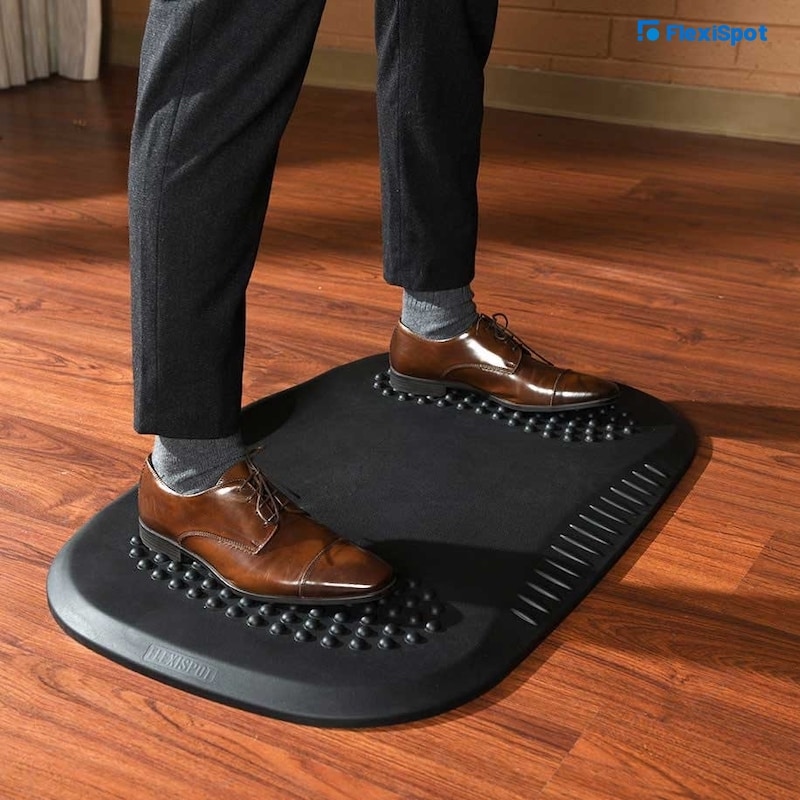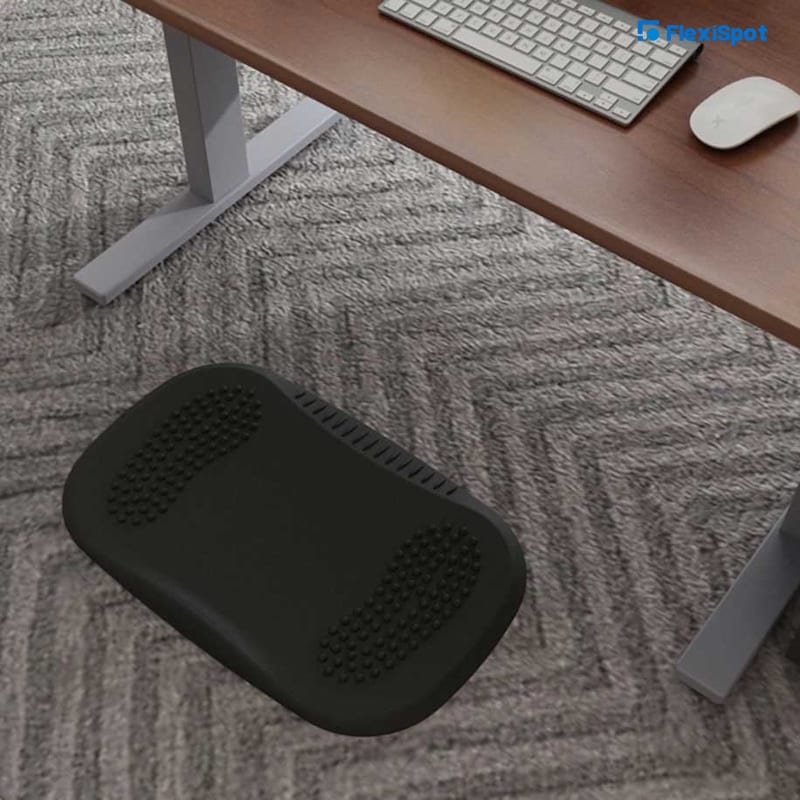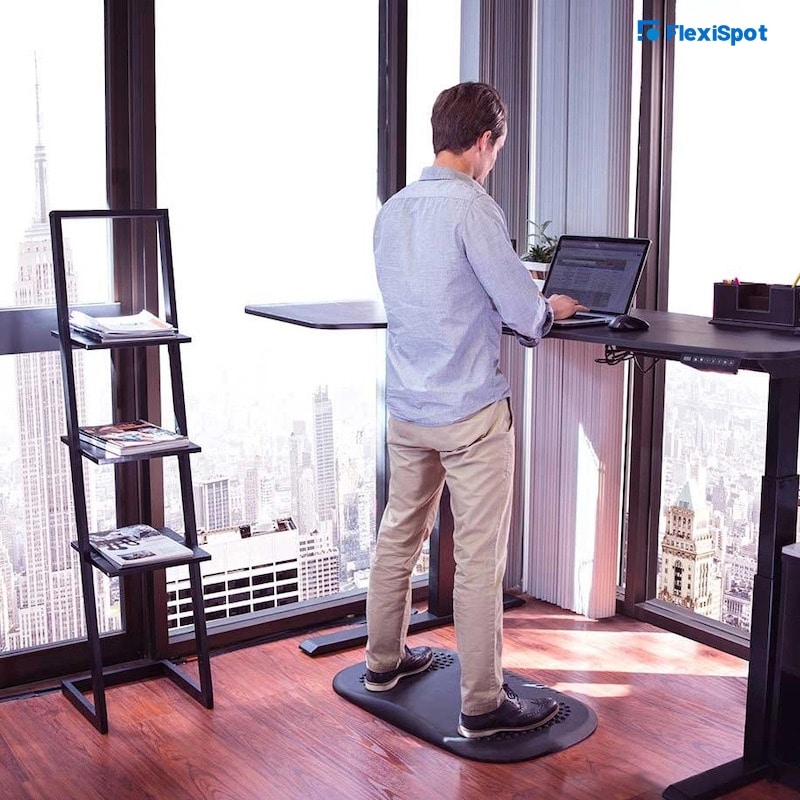Sitting all day will kill you before your time, and so will standing—to stay healthy, we need to keep moving. The best thing would probably be to go back to hunting and gathering and carrying spears to defend ourselves from saber-toothed tigers like our ancestors did. Ahh, those were the days!
Alas, in the developed world at least, the threats to our health and safety no longer come from giant, carnivorous beasts—instead we have heart disease, degenerating joints, and chronic pain.
But since the paleo diet is about the closest most of us will get to the active lifestyle of our forebears, we have to strive for the next best thing, which is building more movement into our day and making any stationary time as safe and comfortable as possible.
One way to accomplish this when you’re standing at work, or even in the kitchen at home, is to include an anti-fatigue mat in your health arsenal.
They’re inexpensive, easily transportable, and may help prevent the ills of standing, like cardiovascular strain, swelling ankles, and bulging or varicose veins. Let’s explore these little gravity-defying marvels of ergonomic engineering.

6 Benefits of Anti-Fatigue Mats
Quality standing mats provide a ton of benefits over standing on a hard floor, or even carpet. The secret it in having enough support as well as enough give to stand comfortably.
Reduced compression
Standing on hard surfaces for long periods compresses your feet, spine, and weight-bearing joints. Ultra-soft surfaces aren’t ideal either—they’re too unstable and you can end up sinking through them and feeling the floor underneath anyway. A good anti-fatigue mat will provide stable support as well as enough give to take the strain of your body.
Improved Circulation
That compression from standing on hard surfaces causes leg muscles to tighten, restricting blood flow. Your calf muscles act as a kind of second heart when you walk and move, helping pump blood back up your legs to your actual heart. When these muscles become stiff and tight from standing, their pumping ability is reduced, making your heart work harder. This is one reason prolonged standing is associated with heart problems.
Save the Knees
Your knees can also suffer from too much standing. These large, complex joints may be amazing at helping us move around, but bearing a lot of weight and compressive force for long periods of time can strain the ligaments, tendons, and muscles that keep them functioning.
Comfort
Just because your work is stressful doesn’t mean you have to be uncomfortable too. Studies have found almost universally that the experience of pain and discomfort is reduced with an anti-fatigue mat.
Energy
They don’t call it an anti-fatigue mat for nothing. The reduced strain on your muscles, joints, and heart will help you conserve your energy for the task at hand and help you avoid feeling worn out by the end of the day (or by your first coffee break, for that matter).
Actually Sit Less
Having a sit-stand desk doesn’t necessarily mean you end up sitting less. Studies show that on average, people still end up sitting more than they should, even when they have the equipment to help them stand more. Why is that? Probably because standing can be tiring and uncomfortable. But with an anti-fatigue mat to go with your awesome desk, you’ll be more likely to get up off your rear more often.

How to Choose a Standing Desk Mat
Materials:
Standing desk mats are typically made of some kind of foam. Look for something that’s not too soft, as it will be less likely to hold up to the pressure. If you can feel the floor through the mat, send it back. Be sure to check the weight capacity and make sure it’s rated high enough for that beach bod of yours.
Design:
Depending on your preference, you can choose from a variety of styles. Some mats provide simple, flat surfaces, whereas others provide various foot-massaging points, ridges, or mounds, which can stimulate pressure points under your feet.
Be sure to look for a tapered edge to avoid tripping, and choose a mat with a non-slip bottom surface so you don’t find yourself unexpectedly sitting instead of standing.
Size and thickness:
Measure the spots where your mat will go both when you’re using it and when you put it away so you can sit. Then pick a mat that fits.
In terms of thickness, many basic, flat mats are ¾-1 inch, while contoured options can be up to a couple of inches, which makes it easier to kick it out of the way when you’re ready for some chair time.

How to Get the Most Benefit From an Anti-Fatigue Desk Mat
Even when using an ergonomic mat at work, avoid standing for extended periods of time, and shift positions while you are standing. You can shift your weight from side to side as well as front to back. Try bouncing a little, walking in place, rolling your ankles in the air, and going up on tiptoe once in a while. The point is to keep moving, like your great-great-grandaddy did.
Build more movement into your day by taking stretch and walking breaks at regular intervals. This will keep your muscles from tightening and restricting blood flow.
Alternate between sitting and standing by using a height-adjustable desk or desk converter. This makes it easy to switch between sitting and standing without breaking your workflow.
Wear supportive shoes with the proper amount of arch support for your feet to further enhance the benefits of your anti-fatigue mat.
Finally, remember that even if work is stressful, at least there’s not a wild beast trying to make a meal of you. So relax, enjoy your work, and get yourself an anti-fatigue mat so you can enjoy the rest of your life too.
